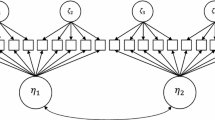Abstract
This paper deals with two-group classification when a unidimensional latent trait,ϑ, is appropriate for explaining the data,X. It is shown that ifX has monotone likelihood ratio then optimal allocation rules can be based on its magnitude when allocation must be made to one of two groups related toϑ. These groups may relate toϑ probabilistically via a non-decreasing functionp(ϑ), or may be defined by all subjects above or below a selected value onϑ.
In the case where the data arise from dichotomous items, then only the assumption that the items have nondecreasing item characteristic functions is enough to ensure that the unweighted sum of responses (the number-right score or raw score) possesses this fundamental monotone likelihood ratio property.
Similar content being viewed by others
References
Birnbaum, A. (1968). Some latent trait models and their use in inferring an examinee's ability. In F. M. Lord & M. R. Novick (Ed.),Statistical theories of mental test scores (pp. 397–479). Reading, MA: Addison-Wesley.
Duncan-Jones, P., Grayson, D. A., & Moran, P. A. P. (1986). The utility of latent trait models in psychiatric epidemiology.Psychological Medicine, 16, 391–405.
Ferguson, J. S. (1967).Mathematical statistics: A decision theoretic approach. New York: Academic Press.
Huynh, H. (1975). Statistical consideration of mastery score.Psychometrika,41, 65–78.
Lehmann, E. L. (1959).Testing statistical hypotheses. New York: John Wiley and Sons.
Lord, F. M. (1980).Applications of item response theory to practical testing problems. Hillsdale, NJ: Lawrence Erlbaum.
Minc, H. (1978).Permanents. Reading, MA: Addison-Wesley.
Rasch, G. (1960).Probabilistic models for some intelligence and attainment tests. Copenhagen: Denmarks Paedagogiske Institut.
Author information
Authors and Affiliations
Rights and permissions
About this article
Cite this article
Grayson, D.A. Two-group classification in latent trait theory: Scores with monotone likelihood ratio. Psychometrika 53, 383–392 (1988). https://doi.org/10.1007/BF02294219
Received:
Revised:
Issue Date:
DOI: https://doi.org/10.1007/BF02294219




